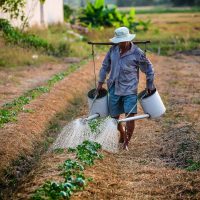Fertilizer

Growing roses
July 26, 2019Fertilizer – What is it?
Fertilizers are actually substances that are produced by chemical processes or by plant extraction, and are used to feed the plant and improve its development. What is their importance, how to fertilize and more in the next article.
By: Ronen Kozushner, Natural Green Seeds
What should be fertilized for?
To understand the issue, one must first understand the growth process of our plant. Once we have planted the plant, it begins to develop roots in the soil. Once the plant develops its initial roots, they begin to drain the water and all the materials needed for the plant’s best development. Generally, the land on which we grow our plants is found to be incomplete or full of the various materials the plant needs in order to develop, hence the need to produce and develop products to fill this deficiency.
What is the importance of fertilizers?
Fertilizers are basically the building blocks of all plant tissues, from plant germination to fruit ripening. Different fertilizers have different roles in the plant. Fertilizers participate in all plant metabolic cycles and optimize plant growth, helping us to plant the leaves so that the plant can photosynthesize, and later, after flowering the plant and the mantle (flower transition to fruit) the fertilizers help us to keep the fruit from the tree and not fall from the tree So we will lose the crop for which we bother.
How do we know that our plants need fertilizer?
As a principle, every plant has its own way of signaling us that it needs fertilizer. The lack of fertilizers will be reflected, most often in the leaves, in the fruit, and possibly in other parts of the plant, if the size or shape of the leaves (yellow or light green leaves when the transport tubes have conspicuous green color, brown spots on the leaf margin), the size of the fruit and other parts of the plant. Of course, each plant has its own specific signs. It should be noted that there may also be an excess state of fertilizer. This can cause soil salinity and thus delay rather than accelerate plant development.
What do fertilizers consist of?
Fertilizers are made up of macro elements and micro elements. Macro elements – N – Nitrogen, P – Phosphorus, K – Potassium, and micro elements such as zinc, iron, molybdenum, copper, magnesium, etc. The plant needs a relatively large amount of macro elements, specific to each plant and plant and micro elements in the smallest amount. The liquid fertilizers, besides the fact that they contain NPK, also contain all the micro elements, but there are only one micro or macro element fertilizer, which can be given to plants growing in soil where only one specific element is missing. These fertilizers will be carried out according to the deficiencies that exist in the same soil, variety, concentration and frequency. And messages which you can get by professionals.
So how do fertilizers?
The fertilizer can be added directly to the soil, through the water irrigation system in which we water the plants or through spraying the plant leaves. At the beginning of the crop, the fertilizers are added directly to the soil, and during the growing is done through the irrigation system using a pump that draws the fertilizer from the tank according to the amount of water passing through the irrigation system so that the fertilizer given to the plants is at an optimal level. The soil-borne fertilizer was annexed partly to the soil, partly penetrated to the plant through the roots and partly washed to the depth of the soil. This method is used both in the agricultural sector and in public and private gardening.
How can the effect of fertilizer be improved?
Apart from fertilizers, there are additives we give to the soil, such as compost and chemicals that improve the absorption of fertilizers from the soil to the plant through the roots. Another way to increase the absorption of fertilizers is to use a material called “area” which helps greatly in introducing the fertilizers provided with foliage spray on the plant. Of course, the use of fertilizers and other substances that help them to be absorbed into the plant should be in accordance with their precise guidelines and application, as increased uncontrolled or high dosage use may be more harmful than beneficial, but lack of sufficient use will probably not produce the desired result.
When should you fertilize?
Fertilization is done in the spring, summer and fall months. During the winter season, usually no fertilizers, because the lie and metabolism of the plant is slower. During the winter, just before spring, fertilizers can be fertilized to strengthen the plants in anticipation of the growing season.
Are there any plants that do not need fertilization at all? Yes, plants such as backgrass, dandelion and various forest trees do not need fertilization






